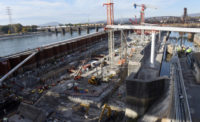President Trump’s budget proposal for fiscal year 2020 seeks to cut overall nondefense discretionary spending by 5% from this year’s level, a plan that, if carried out, wouldn’t bode well for most federal infrastructure and construction programs, which fall into that category. At the same time, the White House again used the budget rollout to recommend a big, long-range infrastructure investment package.
In the near term, the president’s 2020 budget request, released on March 11, includes cuts for some key construction accounts, partly because his plan doesn’t maintain most of a $10-billion-plus boost in overall infrastructure spending contained in a two-year, bipartisan House-Senate budget deal reached in February 2018.
Trump's proposal also would lift defense spending by 5%, which would include an increase for military construction.
Steve Hall, American Council of Engineering Companies senior vice president for advocacy and external affairs, says Congress isn’t likely to agree to the administration’s proposed infrastructure cutbacks.
He says, “I don’t think Congress is going to walk away from the level of commitment to infrastructure that characterized the last two years of spending—and particularly with the emphasis this year on infrastructure.”
Brian Turmail, spokesman for the Associated General Contractors of America, says that “it is likely that this budget will be treated like most other administration budget proposals—a messaging document that will guide many of the comments and reactions to the president’s agenda, but have little direct impact on the decisions appropriators make.”
By far the highest-profile construction item in Trump’s budget request is the $8.6 billion he is seeking for a wall on the U.S. border with Mexico. It includes $5 billion for the Dept. of Homeland Security and $3.6 billion from Dept. of Defense construction.
It sets up a reprise of the fierce fight over border wall funding that shut much of the federal government for several weeks this winter and threatened to start a new shutdown.
The standoff ended in mid-February after Congress approved an appropriations package that allowed the affected agencies to stay open through open through Sept. 30. Trump signed the bill, though Congress provided only $1.375 billion for border fencing.
Infrastructure plan redux
The administration continues to try to keep the idea of a comprehensive infrastructure package alive. A fact sheet accompanying the 2020 budget request calls on Congress to pass legislation providing $200 billion, presumably over 10 years, in federal spending. The administration says that would spark up to $1 trillion in nonfederal investment, including dollars from the private sector
The $1-trillion figure is down markedly from the $1.5 trillion that the administration proposed in its budget last year.
Administration officials this year appear to be changing their game plan and letting Congress take the lead in drafting infrastructure legislation.
In a March 11 briefing for reporters on the new budget, a senior administration official, speaking on background, acknowledged that the latest infrastructure proposal iteration has fewer specifics than in the past, partly because “we really do want to work with Congress on this and we are open to how they construct a package that the president could sign.”
U.S. Transportation Secretary Elaine Chao told reporters later in the day, “We’re going to be looking at things I think from a new point of view. We learned from last year’s proposal.”
Chao added, “We had hoped that there’d be a greater acceptance of the private sector coming into help finance public infrastructure and unfortunately there seems to be a great deal of mistrust of the private sector coming in, helping to finance public infrastructure.”
An ENR review of White House, department and agency budget statements shows that many construction accounts would be reduced from enacted 2019 levels.
Modest highway hike
At the Dept. of Transportation, the request would trim all discretionary funding by 22%. But it also would provide $46.4 billion for the highway obligation limit, a 2% increase from 2019 and the level authorized in the 2015 Fixing America’s Surface Transportation (FAST) Act. [View DOT budget briefing book here.]
The proposal would boost DOT’s popular Better Utilizing Investments to Leverage Development (BUILD) grants by 11%, to $1 billion. The decade-old program originally was named Transportation Investment Generating Economic Recovery, or TIGER.
The 2020 DOT budget also would include $1 billion for the next round of Infrastructure for Rebuilding America grants, established under the FAST Act, for major highway projects.
But the administration also is seeking to slice the Federal Transit Administration’s Capital Investment Grants by 41%, to $1.5 billion. That program funds new transit starts. Chao defended the proposal. She said, “Our request fully funds all existing projects and in addition still reserves $500 million for new projects.”
The Federal Aviation Administration’s Airport Improvement Program infrastructure grants, financed by the Airport and Airway Trust Fund, would be frozen at last year’s $3.35 billion. It also pares FAA discretionary airport grants, which draw on the general fund, to $300 million, down from $500 million this year.
DOD, Corps, EPA, VA, GSA
Within the DOD section of the budget request, military construction spending would climb 9%, to $11.2 billion. DOD also is seeking an additional $9.2 billion in emergency funds for "unspecified" construction projects, according to DOD budget documents. DOD does say the work would include rebuilding facilities damaged by Hurricanes Florence and Michael.
Elsewhere in the budget, the Army Corps of Engineers civil-works program would be slashed by 31%, to $4.8 billion.
The Environmental Protection Agency’s water infrastructure program would see its funding plummet 35%, to $2.8 billion under the Trump request.
The EPA water total includes a combined $1.98 billion for the clean water and drinking water state revolving funds, a 31% drop from 2019, when each set of revolving funds got a $300- million hike, thanks to the budget deal.
Dept. of Veterans Affairs construction accounts for major and minor projects would receive a total of $1.6 billion, down sharply from 2019’s nearly $3 billion. The 2019 figure also included an infusion from the House-Senate bipartisan budget agreement. A big item in the 2020 plan is $410 million for a new VA hospital in Louisville, Ky.
The General Services Administration 2020 budget is asking for $649 million for construction and acquisition of federal buildings—down from $959 million in 2019. But GSA repairs and upgrades for such facilities would jump to $1.7 billion from $663 million this year.
Story corrected on 3/14/19 to say that proposed funding for DOT Infrastructure for Rebuilding America would be $1 billion.





Post a comment to this article
Report Abusive Comment